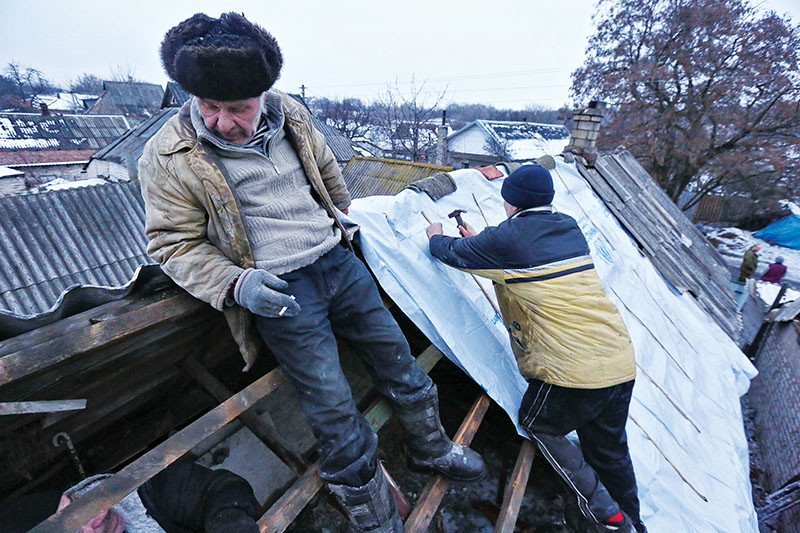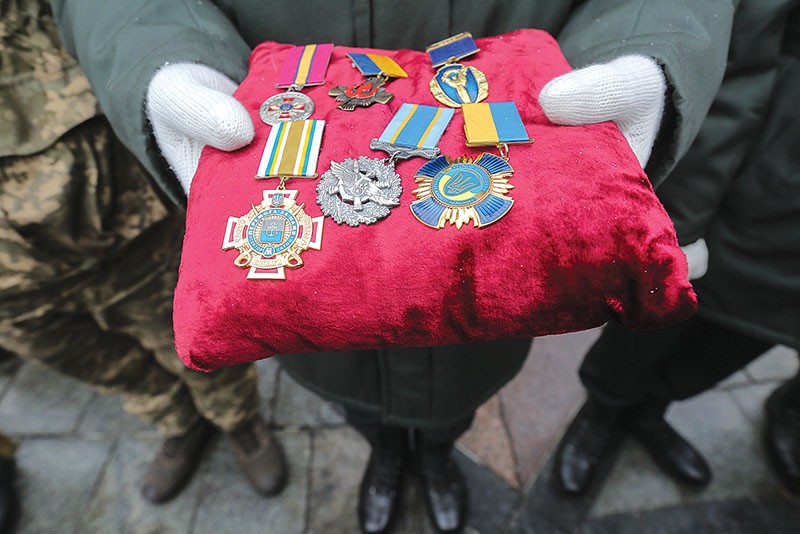AVDIYIVKA, Ukraine – The war-ravaged city of Avdiyivka finally got some peace this week. As the guns fell silent, repair crews restored electricity to the strategically vital city of 20,000 residents, home to a giant coke plant that fuels Ukraine’s steel industry.
Some residents patched roofs shattered by shell shrapnel. Others lined up for humanitarian aid packages.
But the situation remains tense in the city, some 700 kilometers southeast of Kyiv, and the fragile cease-fire between Ukrainian troops and Russian-backed forces might not last long.
“What we see now is not very encouraging,” a member of the OSCE’s Special Monitoring Mission in Ukraine told the Kyiv Post this week. Because the monitor was not officially authorized to comment, the person asked not to be identified.
“The military tension remains very high, and a new outbreak of warfare could happen any moment now, as the opposing troops are deployed close to each other along the frontline, and their heavy weapons and combat vehicles have not pulled back,” the monitor said. “ “Both sides remain hostile to each other. However, in the past couple of days, we’ve seen that both sides are generally respecting the ceasefire at last. Thanks to this silence, a lot can improve here now in Avdiyivka.”
Heavy clashes
Avdiyivka is only 10 kilometers north of Russian-controlled Donetsk. A sharp escalation in fighting started on Jan. 29 and lasted for a week.
As Russian-backed forces and the Ukrainian units defending the city clashed in its southern outskirts, civilians in residential areas came under attack by heavy artillery, including deadly and indiscriminant salvos of Grad rockets.
At least 20 people, both soldiers and civilians, were killed and the ferocity of the battle again put Russia’s war against Ukraine in the headlines around the world.
The fighting also caused a week-long blackout and cut supplies of water, gas and heating in much of the city, even as temperatures plunged to –20 degrees Celsius.
More fighting could create a humanitarian catastrophe.
Even before the latest surge in fighting, nearly three years of war had left marks on the city. Many buildings bear the scars of shrapnel from artillery shells or Grad rockets. Many of their windows are broken, boarded up with plywood or covered with tarpaulin or plastic sheeting.
One shell fired by Russian-backed forces narrowly missed a local public school building, gouging a huge crater in the schoolyard.
In city’s private housing sector, situated close to the frontline near the southeast industrial zone, there are shell craters up to 1.5 meters deep – evidence of the use of heavy caliber artillery forbidden under the Minsk peace agreements.
Natalia Honcharenko, a housewife living in Avdiyivka’s private housing sector, looks out on her yard, which was shattered by the impact of a Grad rocket on Feb. 1. Her grain store, fence and outdoor kitchen were blown away by the explosion.
“Of the 11 rabbits I used to have, only one survived that shelling,” she said. “After the explosion blew away half of my house, I was so shocked and terrified that I couldn’t stop shouting. I was just standing among the debris by myself and yelling.”

Men repair the roof of a house in Avdiyivka on Feb. 5. (Volodymyr Petrov)
Humanitarian aid
The clashes between the sides significantly decreased, both in intensity and in frequency from Feb. 5. In Avdiyivka, any day of relative peace is an opportunity to repair damage to the city and stave off disaster from its people.
After several failed attempts, during which they came under fire by Russian-backed forces, Ukrainian repair crews managed to fix downed power lines. By the morning of Feb. 6, power had been restored across the city, according to Ukrainian Prime Minister Volodymyr Groysman.
Ukraine’s Emergency Situations Service reported that five schools and four kindergartens reopened that day. Local authorities say that since supplies of liquefied gas arrived at Avdiyivka’s famous coking plant, the biggest in Europe, the average temperature in residential housing has gradually increased to 22 degrees Celsius. It had sunk as low as 12 degrees Celsius at the height of the shelling. The plant’s furnaces are the source for much of the city’s centralized heating system.
“As of now, we consider the humanitarian situation in the city to be acceptable,” Valeriy Kobush, an official from Donetsk Oblast State Administration overseeing aid efforts, told the Kyiv Post.
“Avdiyivka has received over 230 tons of humanitarian aid so far, including over 5,000 food packages,” he said. “Aid is constantly being sent from all around Ukraine, and from all of the world’s biggest charity agencies. Every day we deliver at least 1,500 food packages, which is pretty much enough to be sure that people aren’t starving in Avdiyivka.”
Kobush also said that only 250 residents asked to be evacuated.
Avdiyivka’s residents go to one of the two schools used as distribution points or to a tent camp set up on the city’s football field, where the government provides hot food, fresh water, tea and shelter from the cold. Police in vans distributed food to elderly who could not reach the tent.
Residents are grateful for the aid, but sorry about the circumstances.
“I wish I had a normal job,” said Maria Romanchenko, a young woman standing in line for an aid package near a police van. “Our coal plant used to employ nearly all of us. Now it’s suspended due to the war, and we have nowhere to earn a living. Those who were able to left the city a long time ago, and those weren’t – like me – are standing in this bread line.”
“To be honest, I feel terribly embarrassed about this,” said Mykola Patrushev, a 28-year-old father of two children. “But I’ve got children, and my low-paid job doesn’t always allow me to earn enough money.”

A honor guard holds medals of a killed soldier during the farewell ceremony for seven soldiers killed near Avdiivka on the Independence Square on Feb. 1. (Volodymyr Petrov)
Enemy within?
The people in line sometimes quarrel with each other. The frayed tempers are signs of mental exhaustion amid the hardship and horror of shelling.
“We need peace and quiet more than anything else,” says one old woman in the line, who refuses to give her name. “Set us free of war, and normal life will be restored in this city in weeks.”
She shows her passport to one of the officials distributing the aid from the van, and is given a package of food – buckwheat, oil, tinned meat and fish. She turns and walks away.
But while the fighting in Avdiyivka has subsided, there’s no sign of an end to Russia’s war on Ukraine. Both sides mistrust each other. Ukrainian troops defending Avdiyivka even think there might be traitors hiding among the civilian population.
“What was happening a week ago was a kind of nightmare,” says one Ukrainian officer, who refused to identify himself for security reasons. “The city was being shelled relentlessly. But we also know that there’s a rat. When the shelling begins, someone starts striking both military forces and civilian objects with a mortar from within the city. There’s probably someone with a mortar in a hiding place who hits us when the time is right for him.
We’ve been trying to flush this shooter out for weeks, but we can’t just search every house over there.”
That’s life in Avdiyivka, still on the edge of war.
